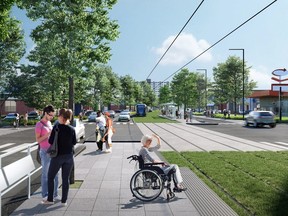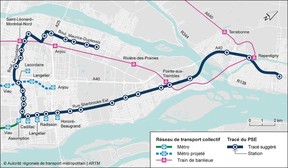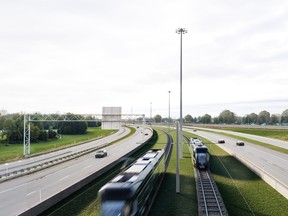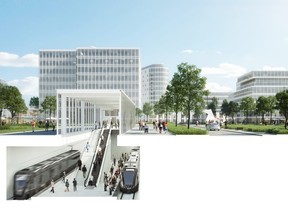The project would cost $18 billion and link to the métro’s Green Line with a train or tramway.

Article content
Difficult to believe but true: a tramway running at 30 kilometres per hour on Montreal’s streets could save east-end residents more than an hour on their daily commutes.
Those were the findings of the region’s planning body for transit, the ARTM, released on Friday during a virtual news conference, to unveil the final recommendations for a transit system that would serve the city’s east end, and link to Repentigny.
Advertisement 2
Story continues below
Article content
The estimated price tag is $18 billion, which would make it the costliest transit project in the province’s history and cover 38 kilometres with 31 stations.
The plan does not include linking any parts of the project to the downtown core. Instead, two branches would lead from the eastern extremity of the Green Line at the current Honoré-Beaugrand terminus. One branch would head north along Lacordaire Blvd. towards Montreal North, ending at Cégep Marie Victorin. The other branch would run along Sherbrooke St. E., cross the river and then follow Highway 40, ending in Repentigny.

Because the project would serve close to 100,000 people daily, the ARTM said buses would not be sufficient to handle that passenger load, but it also doesn’t justify a métro. For that reason a tramway or light-rail system is being recommended. However, the drawback is slow commuting time because of speed limits. In the city, the tramway would run on average at 30 kilometres per hour, while it could reach speeds of 100 km/h along Highway 40. Despite this limitation, planners believe the proposed route would save 59 minutes for residents of Pointe-aux-Trembles who currently drive downtown. It could transport them in 41 minutes, compared to the current average driving time of one hour and 40 minutes. It would also save transit users who access the Green Line between 10 and 22 minutes, the report found.
Article content
Advertisement 3
Story continues below
Article content
The project, which could be ready to run by 2036, is significantly scaled back from the first version, a $36-billion plan that was panned on arrival by Premier François Legault almost a year ago. This version of the project eliminates a tramway along Notre-Dame St., saying that it’s a scenario that can be revisited when the Green Line is at its capacity. The ARTM took over planning of East End transit after the Caisse de dépôt et placement du Québec’s plan was nixed by the city province in 2022. That project would have cost $10 billion.
The plan was greeted favourably by the Chamber of Commerce of Greater Montreal, while the Chamber of Commerce of Eastern Montreal said it is open to the project, but hoped for a direct link to the downtown core.

Sarah Doyon of transit lobby group Trajectoire Québec said her group believes “a tramway on Notre-Dame should be done quicker, because there is a significant population that can be served there.”
However, she said her group is open to the project and despite its high price tag, and she’s optimistic that the project will actually see the light of day.
Advertisement 4
Story continues below
Article content
“There is a consensus at the moment on the needs to improve transit in the east end,” Doyon said. “I have hope that this project will be the one that’s finally chosen.”
In a statement, Transport Minister Geneviève Guilbault also welcomed the report.
“At first brush, this proposal holds true to our promises to redevelop and open up the East End, and connect the Lanaudière region to a transit system,” she wrote. “The project must go ahead with the best price and a respect for Quebecers’ wallets.”
Guilbault recently paved the way to create a new independent agency to plan and put in place public transit infrastructure projects across Quebec which she said will save money by bringing major projects to fruition in the most efficient ways possible. It is hoped this new body Mobilité Infra Québec will take on this project.

Montreal’s opposition party said it was disappointed.
“After decades of waiting, Ensemble Montréal was counting on a more ambitious project,” leader Aref Salem said, adding that a tramway is a slow mode of transit. However, if it is a choice a tramway or nothing, he said the project should at least be brought to fruition as quickly and efficiently as possible.
Recommended from Editorial
Advertisement 5
Story continues below
Article content
Article content


Comments